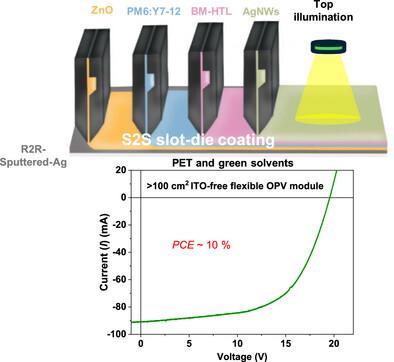Flexible ITO‐Free Organic Solar Modules Using Fully Roll‐to‐Roll Processable Top Illumination Design
IF 26
1区 材料科学
Q1 CHEMISTRY, PHYSICAL
引用次数: 0
Abstract
Organic photovoltaics (OPVs) have reached above 20% Power Conversion Efficiency (

柔性无ITO有机太阳能组件,采用全卷对卷可加工顶部照明设计
近年来,有机光伏(OPVs)的功率转换效率(PCE)已达到20%以上。然而,所有最先进的设备都是用很大程度上不适合工业兼容的卷对卷(R2R)涂层方法的技术制造的。在这项研究中,采用了一种混合方法,结合了R2R真空和溶液镀膜方法的优点,在顶部照明配置中在玻璃和柔性聚对苯二甲酸乙二醇酯(PET)上制造有机太阳能组件。采用R2R溅射技术开发了不透明底电极,以实现低片电阻和降低表面粗糙度。器件中的剩余层,包括顶部透明银纳米线(AgNWs)阳极,在环境条件下使用更环保的溶剂,使用R2R兼容槽模涂层方法进行优化。使用这种无ITO可扩展OPV架构,玻璃基板上的最佳器件实现了13.5%的PCE。当器件扩展到有效面积为12.8 cm2的微型模块时,PCE达到了同样令人印象深刻的12.5%。此外,在尺寸为24 cm x 17 cm的PET基板上开发了6个微型模块,PCE高达11.5%,是同类产品中最高的。这项研究强调了使用工业兼容方法开发高性能、低成本、机械适应性强的无ITO器件的潜力。
本文章由计算机程序翻译,如有差异,请以英文原文为准。
求助全文
约1分钟内获得全文
求助全文
来源期刊

Advanced Energy Materials
CHEMISTRY, PHYSICAL-ENERGY & FUELS
CiteScore
41.90
自引率
4.00%
发文量
889
审稿时长
1.4 months
期刊介绍:
Established in 2011, Advanced Energy Materials is an international, interdisciplinary, English-language journal that focuses on materials used in energy harvesting, conversion, and storage. It is regarded as a top-quality journal alongside Advanced Materials, Advanced Functional Materials, and Small.
With a 2022 Impact Factor of 27.8, Advanced Energy Materials is considered a prime source for the best energy-related research. The journal covers a wide range of topics in energy-related research, including organic and inorganic photovoltaics, batteries and supercapacitors, fuel cells, hydrogen generation and storage, thermoelectrics, water splitting and photocatalysis, solar fuels and thermosolar power, magnetocalorics, and piezoelectronics.
The readership of Advanced Energy Materials includes materials scientists, chemists, physicists, and engineers in both academia and industry. The journal is indexed in various databases and collections, such as Advanced Technologies & Aerospace Database, FIZ Karlsruhe, INSPEC (IET), Science Citation Index Expanded, Technology Collection, and Web of Science, among others.
 求助内容:
求助内容: 应助结果提醒方式:
应助结果提醒方式:


